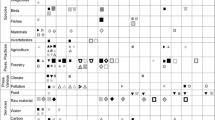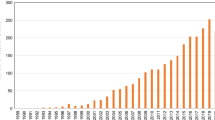Abstract
Global biodiversity monitoring systems through remote sensing can support consistent assessment, monitoring, modelling and reporting on biodiversity which are key activities intended for sustainable management. This work presents an overview of biodiversity monitoring components, i.e. biodiversity levels, essential biodiversity variables, biodiversity indicators, scale, biodiversity inventory, biodiversity models, habitat, ecosystem services, vegetation health and biogeochemical heterogeneity and discusses what remote sensing through Earth Observations has contributed to the study of biodiversity. The technological advancements in remote sensing have enabled information-rich data on biodiversity. Remote sensing data are making a strong contribution in providing unique information relevant to various biodiversity research and conservation applications. The extensive use of Earth observation data are not yet realized in biodiversity assessment, monitoring and conservation. The development of direct remote sensing approaches and the techniques for quantifying biodiversity at the community to species level is likely to be a great challenge for comprehensive earth observation-based monitoring strategy.



Similar content being viewed by others
References
Anderson CB (2018) Biodiversity monitoring, earth observations and the ecology of scale. Ecol Lett 21(10):1572–1585
Bae S, Levick SR, Heidrich L, Magdon P, Leutner BF, Wöllauer S et al (2019) Radar vision in the mapping of forest biodiversity from space. Nat Commun 10(1):1–10
Buhne HST, Pettorelli N (2018) Better together: Integrating and fusing multispectral and radar satellite imagery to inform biodiversity monitoring, ecological research and conservation science. Methods Ecol Evol 9(4):849–865
Chaube NR, Lele N, Misra A, Murthy TVR, Manna S, Hazra S et al (2019) Mangrove species discrimination and health assessment using AVIRIS-NG hyperspectral data. Curr Sci 116:1136
Cord AF, Brauman KA, Chaplin-Kramer R, Huth A, Ziv G, Seppelt R (2017) Priorities to advance monitoring of ecosystem services using earth observation. Trends Ecol Evol 32(6):416–428
Duporge I, Isupova O, Reece S, Macdonald DW, Wang T (2020) Using very-high-resolution satellite imagery and deep learning to detect and count African elephants in heterogeneous landscapes. Remote Sens Ecol Conserv. https://doi.org/10.1002/rse2.195
Feng X, Fu B, Yang X, Lü Y (2010) Remote sensing of ecosystem services: an opportunity for spatially explicit assessment. Chin Geogr Sci 20(6):522–535
Galloway JN, Schlesinger WH Clark CM, Grimm NB, Jackson RB, Law BE, Thornton PE, Townsend AR, Martin R (2014) Ch. 15: biogeochemical cycles. Climate change impacts in the United States: the third national climate assessment. In: J. M. Melillo et al. (eds.). U.S. Global Change Research Program. https://doi.org/10.7930/J0X63JT0.
Geller GN, Halpin PN, Helmuth B, Hestir EL, Skidmore A, Abrams MJ et al (2017) Remote sensing for biodiversity. In: Walters M, Scholes RJ (eds) The GEO handbook on biodiversity observation networks. Springer, Cham, pp 187–210
GOFC-GOLD (2017) A sourcebook of methods and procedures for monitoring essential biodiversity variables in tropical forests with remote sensing. In: GOFC-GOLD. GEO BON (eds.). Report version UNCBD COP-13, GOFC-GOLD Land Cover Project Office, Wageningen University, The Netherlands. ISSN: 2542-6729
Goodwin N, Turner R, Merton R (2005) Classifying eucalyptus forests with high spatial and spectral resolution imagery: an investigation of individual species and vegetation communities. Austral J Bot 53:337–345
Gould W (2000) Remote sensing of vegetation, plant species richness, and regional biodiversity hotspots. Ecol Appl 10(6):1861–1870
Guo QH, Hu TY, Jiang YX, Jin SC, Wang R, Guan HC et al (2018) Advances in remote sensing application for biodiversity research. Biodivers Sci 26:789–806
Herbreteau V, Salem G, Souris M, Hugot JP, Gonzalez JP (2007) Thirty years of use and improvement of remote sensing, applied to epidemiology: from early promises to lasting frustration. Health Place 13(2):400–403
Huber S, Kneubuhler M, Psomas A, Itten K, Zimmermann NE (1997) Estimating foliar biochemistry from hyperspectral data in mixed forest canopy. For Ecol Manage 256(3):491–501
Jones MB, Schildhauer MP, Reichman OJ, Bowers S (2006) The new bioinformatics: integrating ecological data from the gene to the biosphere. Annu Rev Ecol Evol System 37:519–544
Kattenborn T, Lopatin J, Förster M, Braun AC, Fassnacht FE (2019) UAV data as alternative to field sampling to map woody invasive species based on combined Sentinel-1 and Sentinel-2 data. Remote Sens Environ 227:61–73
Kuenzer C, Ottinger M, Wegmann M, Guo H, Wang C, Zhang J, Dech S, Wikelski M (2014) Earth observation satellite sensors for biodiversity monitoring: potentials and bottlenecks. Int J Remote Sens 35:6599–6647
Kumar D, Scheiter S (2019) Biome diversity in South Asia-How can we improve vegetation models to understand global change impact at regional level? Sci Total Environ 671:1001–1016
Lang S, Corbane C, Pernkopf L (2013) Earth observation for habitat and biodiversity monitoring (vol 1, pp 478–486). Verlag der Österreichischen Akademie der Wissenschaften
Lang S, Mairota P, Pernkopf L, Schioppa EP (2015) Earth observation for habitat mapping and biodiversity monitoring. Int J Appl Earth Observ Geoinform 37:1–6
Lawley V, Lewis M, Clarke K, Ostendorf B (2016) Site-based and remote sensing methods for monitoring indicators of vegetation condition: an Australian review. Ecol Indic 60:1273–1283
Lu B, Dao PD, Liu J, He Y, Shang J (2020) Recent advances of hyperspectral imaging technology and applications in agriculture. Remote Sens 12(16):2659
McGarigal K, Cushman S, Regan C (2005) Quantifying terrestrial habitat loss and fragmentation: a protocol. University of Massachusetts, Department of Natural Resources Conservation, Amherst, p 113
McMahon CR, Howe H, van den Hoff J, Alderman R, Brolsma H et al (2014) Satellites, the all-seeing eyes in the sky: counting elephant seals from space. PLoS ONE. https://doi.org/10.1371/journal.pone.0092613
Noss RF (1990) Indicators for monitoring biodiversity: a hierarchical approach. Conserv Biol 4:355–364
O’Connor B, Secades C, Penner J, Sonnenschein R, Skidmore A, Burgess ND, Hutton JM (2015) Earth observation as a tool for tracking progress towards the Aichi Biodiversity Targets. Remote Sens Ecol Conserv 1(1):19–28
O’Neill RV, King AW (1998) Homage to St Michael; or, why are there so many books on scale? In: Peterson DL, Parker VT (eds) Ecological scale: theory and applications. Columbia University Press, New York, pp 3–15
Ortega M, Elena-Rosello R, Del Barrio JG (2004) Estimation of plant diversity at landscape level: a methodological approach applied to three Spanish rural areas. Environ Monitor Assess 95(1–3):97–116
Ozanne CMP et al (2003) Biodiversity meets the atmosphere: a global view of forest canopies. Science 301(5630):183–186. https://doi.org/10.1126/science.1084507
Peterson AT, Knapp S, Guralnick R, Soberón J, Holder MT (2010) The big questions for biodiversity informatics. System Biodivers 8(2):159–168
Pereira HM et al (2013) Essential biodiversity variables. Science 339(6117):277–278
Pettorelli N et al (2016) Framing the concept of satellite remote sensing essential biodiversity variables: challenges and future directions. Remote Sens Ecol Conserv 2(3):122–131
Radeloff VC, Dubinin M, Coops NC, Allen AM, Brooks TM, Clayton MK, Costa GC, Graham CH, Helmers DP, Ives AR, Kolesov D et al (2019) The dynamic habitat indices (DHIs) from MODIS and global biodiversity. Remote Sens Environ 222:204–214
Reddy CS, Kurian A, Srivastava G, Singhal J, Varghese AO, Padalia H, Ayyappan N, Rajashekar G, Jha CS, Rao PVN (2021) Remote sensing enabled essential biodiversity variables for biodiversity assessment and monitoring: technological advancement and potentials. Biodivers Conserv 30(1):1–14. https://doi.org/10.1007/s10531-020-02073-8
Reddy CS, Saranya KRL, Pasha SV, Satish KV, Jha CS, Diwakar PG, Dadhwal VK, Rao PVN, Krishna Murthy YVN (2018) Assessment and monitoring of deforestation and forest fragmentation in South Asia since the 1930s. Global Planet Change 161:132–148
Rocchini D, Salvatori N, Beierkuhnlein C, Chiarucci A, de Boissieu F, Förster M et al (2021) From local spectral species to global spectral communities: A benchmark for ecosystem diversity estimate by remote sensing. Ecol Inf 61:101195
Roy PS, Kushwaha SPS, Murthy MSR, Roy A, Kushwaha D, Reddy CS, Behera MD, Padalia H, Mathur VB, Singh S, Jha CS, Porwal MC (2012) Biodiversity characterisation at landscape level: national assessment. Indian Institute of Remote Sensing, Dehra Dun, pp 1–254. ISBN 81-901418-8-0
Scholes RJ, Mace GM, Turner W, Geller GN, Jurgens N, Larigauderie A et al (2008) Ecology. Toward a global biodiversity observing system. Science 321:1044–1045
Secades C, O'Connor B, Brown C, Walpole M (2014) Earth observation for biodiversity monitoring: a review of current approaches and future opportunities for tracking progress towards the Aichi Biodiversity Targets. Secretariat of the Convention on Biological Diversity, Montréal, Canada. Technical Series No. 72, 183 pp
Sims DA, Gamon JA (2002) Relationships between leaf pigment content and spectral reflectance across a wide range of species, leaf structures and developmental stages. Remote Sens Environ 81(2–3):337–354
Singh H, Garg RD, Karnatak HC, Roy A (2018) Spatial landscape model to characterize biological diversity using R statistical computing environment. J Environ Manage 206:1211–1223
Skidmore A, Pettorelli N, Coops N, Geller G, Hansen M, Lucas R, Mücher C, O’Connor B, Paganini M, Pereira H et al (2015) Environmental science: agree on biodiversity metrics to track from space. Nature 523:403–405
Soberón J, Peterson T (2004) Biodiversity informatics: managing and applying primary biodiversity data. Philos Trans R Soc Lond Ser B Biol Sci 359(1444):689–698
Stoms DM, Estes JE (1993) A remote sensing research agenda for mapping and monitoring biodiversity. Int J Remote Sens 14(10):1839–1860
Tarr NM (2019) Demonstrating a conceptual model for multispecies landscape pattern indices in landscape conservation. Landsc Ecol 34(9):2133–2147
Tatem AJ, Goetz SJ, Hay SI (2008) Fifty years of earth observation satellites: views from above have lead to countless advances on the ground in both scientific knowledge and daily life. Am Sci 96(5):390
Townsend AR, Asner GP, Cleveland CC (2008) The biogeochemical heterogeneity of tropical forests. Trends Ecol Evol 23(8):424–431
Townsend AR, Asner GP (2013) Multiple dimensions of resource limitation in tropical forests. Proc Natl Acad Sci USA 110(13):4864–4865
Tuominen J, Tarmo L, Viljo K, Reija H (2009) Remote sensing of forest health, geoscience and remote sensing, Pei-Gee Peter Ho, IntechOpen, https://doi.org/10.5772/8283. Available from: https://www.intechopen.com/books/geoscience-and-remote-sensing/remote-sensing-of-forest-health
Turner et al (2003) Remote sensing for biodiversity science and conservation. Trends Ecol Evol 18:306–314
Turner W (2014) Sensing biodiversity. Science 346(6207):301–302
Verner J., Morrison ML, Ralph CJ (1986) Wildlife 2000: modeling habitat relationships of terrestrial vertebrates: based on an international symposium held at Stanford Sierra Camp, Fallen Leaf Lake, California, 7–11 October 1984. University of Wisconsin Press
Zhang Z, Cao L, She G (2017) Estimating forest structural parameters using canopy metrics derived from airborne LiDAR data in subtropical forests. Remote Sens 9(9):940
Acknowledgements
This study has been carried out as part of a project on Biodiversity Characterization at Community level in India using Earth Observation Data. I gratefully acknowledge the Department of Biotechnology and the Department of Space, Government of India for financial support to the project. I am thankful to Director, NRSC, Deputy Director, RSA, NRSC, and Group Head, Forestry and Ecology Group, NRSC, Hyderabad, for suggestions and encouragement.
Author information
Authors and Affiliations
Corresponding author
Additional information
Communicated by Neil Brummitt.
Publisher's Note
Springer Nature remains neutral with regard to jurisdictional claims in published maps and institutional affiliations.
Rights and permissions
About this article
Cite this article
Reddy, C.S. Remote sensing of biodiversity: what to measure and monitor from space to species?. Biodivers Conserv 30, 2617–2631 (2021). https://doi.org/10.1007/s10531-021-02216-5
Received:
Revised:
Accepted:
Published:
Issue Date:
DOI: https://doi.org/10.1007/s10531-021-02216-5




